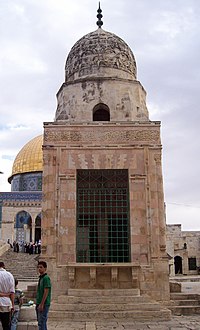Religion:Islamization of the Temple Mount
The Islamization of the Temple Mount is the historical process by which Muslim authorities have sought to adapt the Temple Mount for Muslim use.[1] Once an Israelite and subsequently Jewish holy site, as the location of the Second Temple, the site was subsequently the location of a Roman pagan temple,[2] a Byzantine public building, possibly a church,[3] a garbage dump,[4] and later the Dome of the Rock and the Al-Aqsa Mosque. The Temple Mount is the holiest site in Judaism,[5][6] and the third holiest in Sunni Islam.
Early Muslim period
During his excavations in the 1930s, Robert Hamilton uncovered portions of a multicolor mosaic floor with geometric patterns inside the al-Aqsa mosque, but didn't publish them.[7] The date of the mosaic is disputed: Zachi Dvira considers that they are from the pre-Islamic Byzantine period, while Baruch, Reich and Sandhaus favor a much later Umayyad origin on account of their similarity to a known Umayyad mosaic.[7]
The Islamization of the Temple Mount climaxed at the end of the seventh century, with the construction of the Dome of the Rock in the early 690s when Abd al-Malik was developing his program of Islamization. It was built over the Foundation Stone, the site of the historic Jewish Temple.[8] The al-Aqsa mosque was built at the southern end of the mount in the 8th century. Throughout the entire period of the Early Muslim period, from the Muslim conquest until the Crusader capture of Jerusalem in 1099, various structures were built on the mount including memorial sites and gates.[9]
Crusades and counter-Crusade
The Temple Mount, along with the entire Holy Land, changed hands several times during the Crusader period (1099-1244 for Jerusalem), Christians and Muslims rededicating its buildings to their own religious and power needs every time they managed to wrangle control over them from their respective enemies.[citation needed]
Mamluk and Ottoman periods
From the 13th-century onwards, after the Muslims had regained control of the city, building projects in Jerusalem and around the Temple Mount sought to further establish the city's Islamic character.[10]
Post-1967
In 1990, the waqf began construction of a series of outdoor minbar (pulpits) to create open-air prayer areas for use on popular holy days.[11] A monument to the victims of the Sabra and Shatila massacre was also erected.[11] In 1996, the Waqf began underground construction of the new el-Marwani Mosque in the southeastern corner of the Temple Mount. The area was claimed by the waqf as a space that served in earlier Islamic periods as a place of prayer, but some saw the move as a part of a "political agenda"[12] and a "pretext" for the Islamization of the underground space, and believed it had been instigated to prevent the site being used a synagogue for Jewish prayers.[11][13] A spate over the use of the Golden Gate (Bab adh-Dhahabi) gatehouse as a mosque has followed in 2019.[14]
See also
References
- ↑ Raphael Israeli (2003). War, peace and terror in the Middle East. Psychology Press. pp. 21–. ISBN 978-0-7146-5531-4. https://books.google.com/books?id=I4B11CFdP-oC&pg=PA21. Retrieved 3 October 2010. "During the process of the Islamization of Jerusalem, a mosque was built on the site... The Islamicized Mount became the destination of Muhammad's isra’..."
- ↑ Chisholm, Hugh, ed (1911). "Aelia Capitolina". Encyclopædia Britannica. 1 (11th ed.). Cambridge University Press. p. 256.
- ↑ Etgar Lefkowitz (November 16, 2008). "Was the Aksa Mosque built over the remains of a Byzantine church?". Jerusalem Post. The Jerusalem Post. http://www.jpost.com/Israel/Was-the-Aksa-Mosque-built-over-the-remains-of-a-Byzantine-church.
- ↑ Karmi, Ghada (1997). Jerusalem Today: What Future for the Peace Process?. Garnet & Ithaca Press. p. 116. ISBN 0-86372-226-1.
- ↑ Rivka, Gonen (2003). Contested Holiness: Jewish, Muslim, and Christian Perspectives on the Temple Mount in Jerusalem. Jersey City, NJ: KTAV Publishing House, Inc.. pp. 4. ISBN 0-88125-798-2. OCLC 1148595286. http://worldcat.org/oclc/1148595286. "To the Jews the Temple Mount is the holiest place on Earth, the place where God manifested himself to King David and where two Jewish temples - Solomon's Temple and the Second Temple - were located."
- ↑ Marshall J., Breger; Ahimeir, Ora (2002). Jerusalem: A City and Its Future. Syracuse University Press. pp. 296. ISBN 0-8156-2912-5. OCLC 48940385. http://worldcat.org/oclc/48940385.
- ↑ 7.0 7.1 Yuval Baruch, Ronny Reich & Débora Sandhaus. "A Decade of Archaeological Exploration on the Temple Mount, Tel Aviv". Tel Aviv 45 (1): 3–22. doi:10.1080/03344355.2018.1412057.
- ↑ Matthew Gordon (2005). The rise of Islam. Greenwood Publishing Group. p. 44. ISBN 978-0-313-32522-9. https://archive.org/details/riseofislam0000gord. Retrieved 3 October 2010.
- ↑ Mahdī ʻAbd al-Hādī; PASSIA. (2007). Documents on Jerusalem. PASSIA, Palestinian Academic Society for the Study of International Affairs. p. 247. ISBN 978-9950-305-19-9. https://books.google.com/books?id=JT8vAQAAIAAJ. Retrieved 3 October 2010. "The Islamization of the Temple Mount culminated at the end of the seventh century, with the establishment of the Dome of the Rock above the Foundation Stone and the construction of the al-Aqsa mosque in the south of the Temple Mount."
- ↑ Hava Lazarus-Yafeh (1 December 1981). Some religious aspects of Islam: a collection of articles. Brill Archive. p. 69. ISBN 978-90-04-06329-7. https://books.google.com/books?id=J7k3AAAAIAAJ&pg=PA69. Retrieved 3 October 2010. "In the same way, when Jerusalem was taken back under the leadership of Saladin in 1187, and particularly from the 13th-century and on, a great deal of building activity began around the Temple Mount and in the whole city — obviously so as to establish its Islamic character."
- ↑ 11.0 11.1 11.2 Contested holiness: Jewish, Muslim, and Christian perspectives on the Temple Mount in Jerusalem, Rivka Gonen, KTAV Publishing House, Inc., 2003, p.. 167-8.
- ↑ "Remnants of the Temple?," Danny Rubinstein, September 12, 2004.
- ↑ Hershel Shanks (14 October 2007). Jerusalem's Temple Mount: from Solomon to the golden Dome. Continuum. p. 76. ISBN 9780826428844. https://books.google.com/books?id=9uUuAQAAIAAJ. Retrieved 3 October 2010. "In recent years Solomon's Stables have been in the news. The story is part of the larger story of the recent Islamization of the Temple Mount."
- ↑ "Israel, Jordan said holding talks to end conflict at Temple Mount gate". Times of Israel. 6 March 2019. https://www.timesofisrael.com/israel-jordan-said-holding-talks-to-end-conflict-at-temple-mount-gate/.
External links




